Dometic DC08, DC20, DC40 operation manual
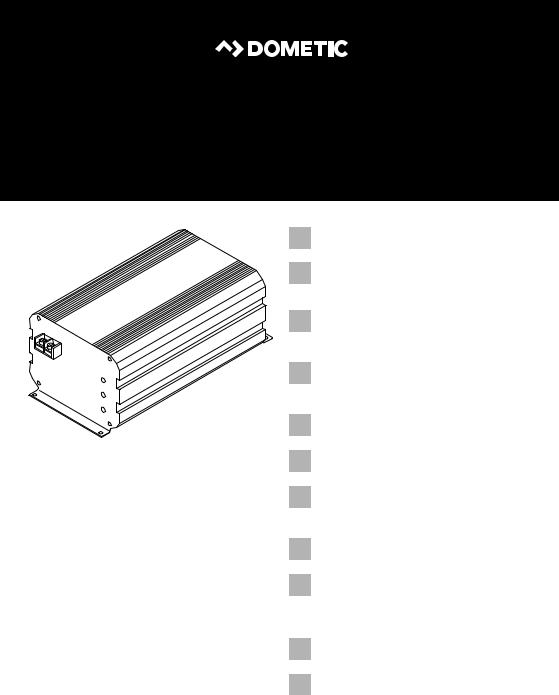
ENERGY & LIGHTING CHARGERS & INVERTERS
POWER |
|
||
BA |
|
|
ON |
TTE |
RY |
|
|
|
LOW |
||
|
|
||
OVERLOAD |
|||
PerfectCharge DC08, DC20, DC40,
DC40 eStore
PerfectPower DCDC10, DCDC20,
DCDC40
EN |
Charger and voltage converter |
|
|
Installation and Operating Manual . . . . . . . . 5 |
|
|
||
|
Ladeund Spannungswandler |
|
DE |
||
|
Montageund Bedienungsanleitung . . . . .20 |
|
|
||
|
Transformateur de charge et de |
|
FR |
||
tension |
||
|
||
|
||
|
Instructions de montage |
|
|
et de service . . . . . . . . . . . . . . . . . . . . . . . . .36 |
|
|
Transformador de carga y tensión |
|
ES |
||
Instrucciones de montaje y de uso . . . . . . .52 |
||
|
||
|
Conversores de carga e |
|
PT |
||
transformadores de tensão |
||
|
|
Trasformatore di carica e di tensione |
|
IT |
|
|
|
Istruzioni di montaggio e d’uso . . . . . . . . |
. 84 |
NL |
Laaden spanningsomvormer |
|
|
Montagehandleiding en |
|
|
gebruiksaanwijzing. . . . . . . . . . . . . . . . . . |
100 |
DA |
Opladningsog |
|
|
spændingstransformer |
|
|
Monteringsog betjeningsvejledning. . . |
116 |
SV |
Laddningsoch |
|
|
spänningsomvandlare |
|
|
Monteringsoch bruksanvisning . . . . . . . |
132 |
NO |
Ladeog spenningsomformer |
|
|
Monteringsog bruksanvisning . . . . . . . . 147 |
|
|
Latausja jännitemuunnin |
|
FI |
|
|
|
Asennusja käyttöohje . . . . . . . . . . . . . . . |
162 |
RU |
Преобразователь-стабилизатор |
|
|
напряжения |
|
|
Инструкция по монтажу и эксплуатации 177 |
|
|
Przetwornik ładowania i napięcia |
|
PL |
|
|
|
Instrukcja montażu i obsługi. . . . . . . . . . . |
194 |
|
Nabíjací transformátor a menič |
|
SK |
|
|
|
napätia |
|
|
Návod na montáž a uvedenie |
|
|
do prevádzky. . . . . . . . . . . . . . . . . . . . . . . |
210 |
CS |
Napájecí měnič s měničem napětí |
|
|
Návod k montáži a obsluze . . . . . . . . . . . |
225 |
HU |
Töltésés feszültségátalakító |
|
|
Szerelési és használati útmutató . . . . . . . 240 |
|
Instruções de montagem e manual de instruções . . . . . . . . . . . . . . . . . . . . . . . . . . .68
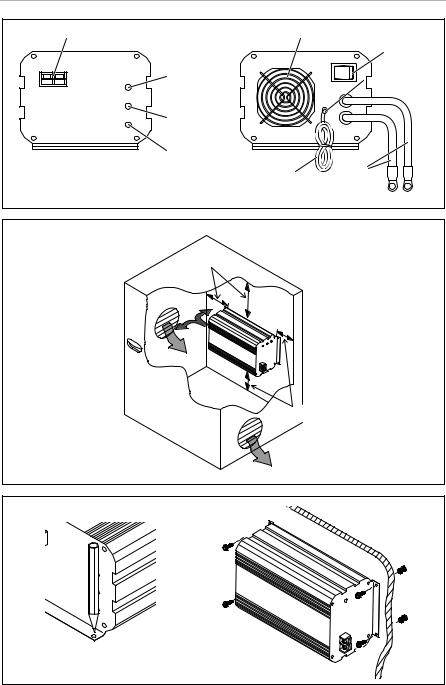
PerfectCharge/PerfectPower
1 |
1 |
|
5 |
|
|
|
6 |
|
2 |
|
0 I |
|
POWER ON |
|
|
|
BATTERY LOW |
|
|
|
3 |
|
|
|
OVERLOAD |
|
|
|
4 |
|
|
|
|
8 |
7 |
|
|
|
2
5 cm
ONPOWER |
WOLY RTTE AB |
OVERLOAD |
5 cm
3 A |
|
B |
|
|
|
BA POWER |
|
|
|
|
TTE |
|
|
|
|
RY |
LOW |
|
|
|
|
|
|
|
|
OVERLOAD |
WLOY RTTE AB |
OVERLOAD |
|
|
|
ONPOWER |
||
|
|
|
|
3 |
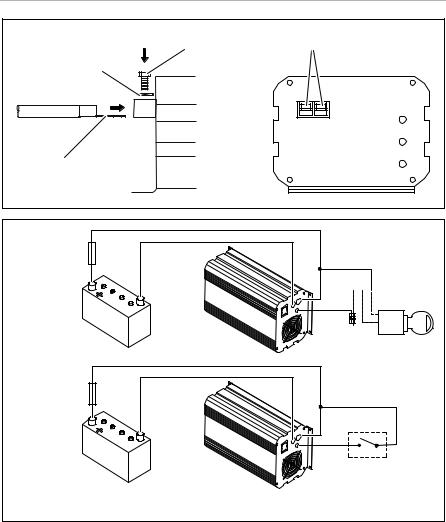
PerfectCharge/PerfectPower
4 |
|
|
4 |
|
|
2 |
|
|
|
|
|
|
|
1 |
|
|
|
|
POWER ON |
|
|
|
BATTERY LOW |
|
3 |
|
OVERLOAD |
5 |
A |
|
|
 0 I
0 I






 15
15
B
 0 I
0 I
4

PerfectCharge/PerfectPower
Please read this instruction manual carefully before installation and first use, and store it in a safe place. If you pass on the product to another person, hand over this instruction manual along with it.
Contents |
|
|
1 |
Explanation of symbols . . . . . . . . . . . . . . . . . . . . . . . . . . . . . . . . . . . . . . . . . . |
.6 |
2 |
General safety instructions . . . . . . . . . . . . . . . . . . . . . . . . . . . . . . . . . . . . . . . |
.6 |
3 |
Scope of delivery . . . . . . . . . . . . . . . . . . . . . . . . . . . . . . . . . . . . . . . . . . . . . . |
11 |
4 |
Proper use . . . . . . . . . . . . . . . . . . . . . . . . . . . . . . . . . . . . . . . . . . . . . . . . . . . . |
11 |
5 |
Technical description . . . . . . . . . . . . . . . . . . . . . . . . . . . . . . . . . . . . . . . . . . . |
12 |
6 |
Mounting the converter . . . . . . . . . . . . . . . . . . . . . . . . . . . . . . . . . . . . . . . . . |
13 |
7 |
Connecting the converter . . . . . . . . . . . . . . . . . . . . . . . . . . . . . . . . . . . . . . . |
14 |
8 |
Using the converter. . . . . . . . . . . . . . . . . . . . . . . . . . . . . . . . . . . . . . . . . . . . . |
16 |
9 |
Cleaning and caring for the converter . . . . . . . . . . . . . . . . . . . . . . . . . . . . . . |
17 |
10 |
Guarantee . . . . . . . . . . . . . . . . . . . . . . . . . . . . . . . . . . . . . . . . . . . . . . . . . . . . |
17 |
11 |
Disposal . . . . . . . . . . . . . . . . . . . . . . . . . . . . . . . . . . . . . . . . . . . . . . . . . . . . . . |
17 |
12 |
Technical data . . . . . . . . . . . . . . . . . . . . . . . . . . . . . . . . . . . . . . . . . . . . . . . . . |
18 |
EN |
5 |
|
|
|
|

Explanation of symbols |
PerfectCharge/PerfectPower |
1Explanation of symbols
DDANGER!
Safety instruction: Failure to observe this instruction will cause fatal or serious injury.
!WARNING!
Safety instruction: Failure to observe this instruction can cause fatal or serious injury.
!CAUTION!
Safety instruction: Failure to observe this instruction can lead to injury.
ANOTICE!
Failure to observe this instruction can cause material damage and impair the function of the product.
INOTE
Supplementary information for operating the product.
2General safety instructions
The manufacturer accepts no liability for damage in the following cases:
•Damage to the product resulting from mechanical influences and excess voltage
•Alterations to the product without express permission from the manufacturer
•Use for purposes other than those described in the operating manual
Note the following basic safety information when using electrical devices to protect against:
•Electric shock
•Fire hazards
•Injury
6 |
EN |
|
PerfectCharge/PerfectPower |
General safety instructions |
2.1General safety
DDANGER!
•In the event of fire, use a fire extinguisher which is suitable for electrical devices.
!WARNING!
•Only use the device as intended.
•Ensure that the red and black terminals never come into contact.
•Disconnect the device from the mains:
–Before cleaning and maintenance
–Before changing a fuse
•If you disassemble the device:
–Detach all connections
–Make sure that no voltage is present at any of the inputs and outputs
•The device may not be used if the device itself or the connection cable are visibly damaged.
•If this power cable for this device is damaged, it must be replaced by the manufacturer, customer service or a similarly qualified person in order to prevent safety hazards.
•This device may only be repaired by qualified personnel. Inadequate repairs may cause serious hazards.
•People (including children) whose physical, sensory or mental capacities prevent them from using this device safely may not be allowed to operate it without the supervision of a responsible adult.
•Electrical devices are not toys.
Always keep and use the appliance out of the reach of children.
•Children must be supervised to ensure that they do not play with the device.
ANOTICE!
•Before start-up, check that the voltage specification on the type plate is the same as that of the power supply.
•Ensure that other objects cannot cause a short circuit at the contacts of the device.
•Store the device in a dry and cool place.
EN |
7 |
|
|
|
|

General safety instructions |
PerfectCharge/PerfectPower |
2.2Safety when installing the device
DDANGER!
•Never mount the device anywhere where there is a risk of gas or dust explosion.
!CAUTION!
•Ensure that the device is standing firmly.
The device must be set up and fastened in such a way that it cannot tip over or fall down.
ANOTICE!
•Do not expose the device to a heat source (such as direct sunlight or heating). Avoid additional heating of the device in this way.
•Set up the device in a dry location where it is protected against splashing water.
2.3Safety when connecting the device electronically
DDANGER! Danger of electrocution
•For installation on boats:
If electrical devices are incorrectly installed on boats, corrosion damage might occur. Have the device installed by a specialist (marine) electrician.
•If you are working on electrical systems, ensure that there is somebody close at hand who can help you in emergencies.
!WARNING!
•Always use an adequate fuse in the positive line between the device and the battery.
•Make sure that the lead has a sufficient cross-section.
•Lay the cables so that they cannot be damaged by the doors or the bonnet.
Crushed cables can lead to serious injury.
!CAUTION!
•Lay the cables so that they cannot be tripped over or damaged.
8 |
EN |
|
PerfectCharge/PerfectPower |
General safety instructions |
ANOTICE!
•Use ductwork or cable ducts if it is necessary to lay cables through metal panels or other panels with sharp edges.
•Do not lay the 230 V mains cable and the 12 V DC cable in the same duct.
•Do not lay the cable so that it is loose or heavily kinked.
•Fasten the cables securely.
•Do not pull on the cables.
2.4Operating the device safely
!WARNING!
•Only use the device in closed, well-ventilated rooms.
•Do not operate the device in systems with lead acid batteries. These batteries give off explosive hydrogen gas that can be ignited by sparks on electrical connections.
!CAUTION!
•Do not operate the device
–In salty, wet or damp environments
–In the vicinity of corrosive fumes
–In the vicinity of combustible materials
–In areas where there is a danger of explosions.
•Before starting the device, ensure that the power supply lines are dry.
•Always disconnect the power supply when working on the device.
•Please observe that parts of the device may still conduct voltage even if the fuse has blown.
•Do not disconnect any cables when the device is still in use.
ANOTICE!
•Make sure the air inlets and outlets of the device are not covered.
•Ensure good ventilation.
EN |
9 |
|
|
|
|

General safety instructions |
PerfectCharge/PerfectPower |
2.5Safety precautions when handling batteries
!WARNING!
•Batteries contain aggressive and caustic acids. Avoid battery fluid coming into contact with your body. If your skin does come into contact with battery fluid, wash the part of your body in question thoroughly with water.
If you sustain any injuries from acids, contact a doctor immediately.
!CAUTION!
•When working on the batteries, do not wear any metal objects such as watches or rings.
Lead acid batteries can cause short circuits which can cause serious injuries.
•Danger of explosions!
Never attempt to charge a frozen or defective battery.
Place the battery in a frost-free area and wait until the battery has acclimatised to the ambient temperature. Then start the charging process.
•Wear goggles and protective clothing when you work on batteries. Do not touch your eyes when you are working on the battery.
•Do not smoke and ensure that no sparks can arise in the vicinity of the engine or battery.
ANOTICE!
•Only use rechargeable batteries.
•Prevent any metal parts from falling on the battery. This can cause sparks or short-circuit the battery and other electrical parts.
•Make sure the polarity is correct when connecting the battery.
•Follow the instructions of the battery manufacturer and those of the manufacturer of the system or vehicle in which the battery is used.
•If you need to remove the battery, first disconnect the earth connection. Disconnect all connections and all consumers from the battery before removing it.
10 |
EN |
|

PerfectCharge/PerfectPower |
Scope of delivery |
3Scope of delivery
Quantity Description
1Converter
1Operating manual
4Proper use
The transformers convert a g or 24 Vg supply from a car or boat battery to a stable DC voltage:
•DC08 (ref. no. 9600000095), DC20 (ref. no. 9600000096), DC40 (ref. no. 9600000097): 12 Vg input voltage to 14.2 Vg output voltage (charge converter)
•DC40 eStore (ref. no. 9600000098): 12 Vg input voltage to 13.8 Vg output voltage (charge converter)
•DCDC10 (ref. no. 9600000084), DCDC20 (ref. no. 9600000086):
12 Vg input voltage to 27.6 Vg output voltage (voltage converter)
•DCDC20 (ref. no. 9600000087), DCDC40 (ref. no. 9600000088):
24 Vg input voltage to 13.8 Vg output voltage (voltage converter)
•DCDC10 (ref. no. 9600000085): 24 Vg input voltage to 27.6 Vg output voltage (voltage converter)
All the converters can also be use to charge lead batteries.
ANOTICE!
Never use the device to charge other battery types (such as NiCd or NiMH).
The output voltage of the voltage converter is 13.8 V/27.6 V.
On charge converters, the output voltage follows an IU charging curve to a maximum of 14.2 V (DC40 eStore: 13.8 V). This means the battery is charged more quickly.
ANOTICE!
Charge converter: Do not charge for longer than twelve hours.
EN |
11 |
|
|
|
|
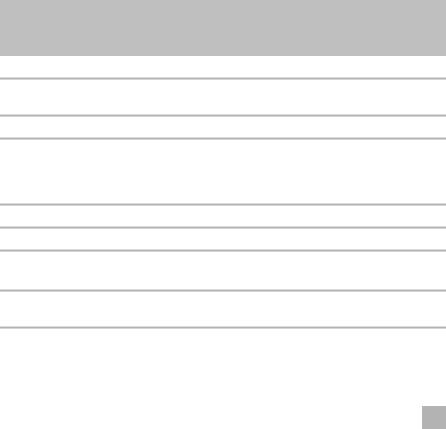
Technical description |
PerfectCharge/PerfectPower |
5Technical description
The light weight and compact construction allows the converters to be easily installed in mobile homes, commercial vehicles or motor and sailing vessels.
The transformers convert a 12 Vg or 24 Vg supply from a car or boat battery to a stable 12 Vg or 24 Vg voltage for connecting to equipment.
The isolation of the input and output voltages means the output voltage can be kept stable without interference from the input circuit.
Because the maximum output current is electronically regulated, the charge converters can be used to charge batteries to generate electricity in cars or on boats.
The devices are equipped with protection against shorting and overloading. If the protective function triggers, the device switches off and then switches on again when correctly connected or when the load has been adequately reduced.
5.1Control elements
No. in
fig. 1, Explanation page 3
1Output terminals
2“Power On” LED: There is voltage at the output terminals on the converter. The converter is ready for use.
3“Battery Low” LED: The input battery is no longer sufficiently charged.
4“Overload” LED:
–If a consumer is connected: The converter is shorted or overloaded.
–If connected as a charger: The converter is in the full current charging phase.
5Air outlet
6Main switch
7Red: Positive cable to input battery Black: Negative cable to input battery
8Connection for switching on with on-board voltage (e.g. ignition or external switch)
12 |
EN |
|

PerfectCharge/PerfectPower |
Mounting the converter |
6Mounting the converter
6.1Mounting instructions
If you wish to mount the converter in a fixed position, please observe the following mounting instructions:
•You can mount the device either horizontally or vertically.
•Do not mount the device
–In wet or damp environments
–In the vicinity of combustible materials
–In areas where there is a danger of explosions
•The place of installation must be well-ventilated. A ventilation system must be
present for installations in small, closed spaces. The minimum clearance around the device must be at least 5 cm (fig. 2, page 3).
•The air intake on the underside or the air outlet on the back of the device must remain clear.
•For ambient temperatures higher than 40 °C (such as in engine or heating compartments, or direct sunlight), the heat from the device under load can lead to the automatic shut-down.
•The installation surface must be level and sufficiently sturdy.
ANOTICE!
Before drilling any holes, ensure that no electrical cables or other parts of the vehicle can be damaged by drilling, sawing and filing.
6.2Mounting the converter
Hold the converter against the installation location and mark the fastening points (fig. 3 A, page 3).
Fasten the converter using your chosen method (fig. 3 B, page 3).
EN |
13 |
|
|
|
|

Connecting the converter |
PerfectCharge/PerfectPower |
7Connecting the converter
7.1Connecting the input battery
!WARNING!
Do not reverse the polarity. Reverse polarity of the battery connections can cause injury and irreversably damage the device.
ANOTICE!
Tighten the nuts or bolts to a torque of 12 – 13 Nm. Loose connections may cause overheating.
Set the main switch (fig. 1 6, page 3) to “0”.
Lay the positive cable (red) (fig. 1 7, page 3) from the converter to positive terminal of the battery and connect it.
Lay the negative cable (black) (fig. 1 7, page 3) from the converter to negative terminal of the battery and connect it.
7.2Connecting the connection cable
You can switch on the device as follows:
•Using the main switch on the device (fig. 1 6, page 3)
•Using the ignition (fig. 5 A, page 4) Terminal 15: Connected positive terminal
•Using an external switch (fig. 5 B, page 4)
Connecting the converter to be switched on via the main switch
Isolate the connecting line so no malfunction can occur.
Connecting the converter to be switched on via the ignition
Connect the connecting line to terminal 15 (connected positive terminal) (fig. 5 A, page 4).
Set the main switch (fig. 1 6, page 3) on the back of the converter to “0” permanently.
14 |
EN |
|
PerfectCharge/PerfectPower |
Connecting the converter |
Connecting the converter to be switched on via an external switch
Connect the connecting line to an external switch (fig. 5 B, page 4).
Set the main switch (fig. 1 6, page 3) on the back of the converter to “0” permanently.
7.3Connecting power consuming devices to the converter
Loosen the screw (fig. 4 2, page 4) from the positive terminal (red) (fig. 4 4, page 4).
Push the cable lug (fig. 4 3, page 4) of the positive cable of the power consuming device into the positive terminal (red) (fig. 4 4, page 4) and attach it using the screw (fig. 4 2, page 4) and the spring washer (fig. 4 1, page 4).
Connect the negative cable of the power consuming device in the same way to the negative terminal (black) (fig. 4 4, page 4).
EN |
15 |
|
|
|
|

Using the converter |
PerfectCharge/PerfectPower |
8Using the converter
You can switch on the device as follows, depending on the connection:
•Using the main switch on the device (fig. 1 6, page 3)
•Using the ignition (fig. 5 A, page 4) Terminal 15: Connected positive terminal
•Using an external switch (fig. 5 B, page 4)
Switching on the converter
Set the main switch (fig. 1 6, page 3) on the back of the converter to “1” …
…or start the ignition …
…or push the external switch.
The LEDs (fig. 1 3 to 5, page 3) indicate the operating status:
LED |
Colour |
Explanation |
|
|
|
Power On |
Green |
The device is switched on and there is voltage at |
|
|
the output terminals on the converter. The |
|
|
converter is ready for use. |
|
|
|
Battery Low |
Yellow |
The input battery is no longer sufficiently |
|
|
charged. |
|
|
Recharge the battery or use a charged |
|
|
battery. |
|
|
|
Overload |
Red |
If a consumer is connected: |
|
|
The converter is shorted or overloaded. |
|
|
Eliminate the short circuit or reduce the |
|
|
output load. |
|
|
If connected as a charger: |
|
|
The converter is in the full current charging |
|
|
phase. |
|
|
|
INOTE
The internal fan is operated according to the temperature. It only runs when the temperature is too high. During this time the converter is switched off to prevent overheating.
16 |
EN |
|

PerfectCharge/PerfectPower |
Cleaning and caring for the converter |
Switching off the converter
Set the main switch (fig. 1 6, page 3) on the back of the converter to “0” …
…or switch off the ignition …
…or push the external switch.
9Cleaning and caring for the converter
ANOTICE! Danger of damaging the device!
Never clean the device under running water or in dish water.
Do not use abrasive cleaning agents or hard objects during cleaning as these can damage the device.
Occasionally clean the device with a damp cloth.
10 Guarantee
The statutory warranty period applies. If the product is defective, please contact the manufacturer's branch in your country (see the back of the instruction manual for the addresses) or your retailer.
For repair and guarantee processing, please include the following documents when you send in the device:
•A copy of the receipt with purchasing date
•A reason for the claim or description of the fault
11 Disposal
Place the packaging material in the appropriate recycling waste bins wherever possible.
MIf you wish to finally dispose of the product, ask your local recycling centre or specialist dealer for details about how to do this in accordance with the applicable disposal regulations.
EN |
17 |
|
|
|
|

Technical data |
|
PerfectCharge/PerfectPower |
||
12 |
Technical data |
|
|
|
|
|
|
|
|
|
|
DCDC10 |
|
DCDC20 |
|
|
|
|
|
Reference no.: |
9600000084 |
|
9600000086 |
|
|
|
|
|
|
Transformation: |
|
12 V →24 V |
||
|
|
|
||
Rated input voltage: |
|
12 Vg |
||
|
|
|
||
Input voltage range: |
|
8 V – 16 V |
||
|
|
|
|
|
Output current: |
10 A |
|
20 A |
|
|
|
|
|
|
Output voltage: |
|
27.6 V ± 0.1 V |
||
|
|
|
||
Efficiency up to: |
|
87 % |
||
|
|
|
||
Interference suppression: |
|
40 mA |
||
|
|
|||
Ambient temperature for operation: |
–20 °C to +50 °C |
|||
|
|
|
|
|
Dimensions W x D x H: |
140 x 115 x 70 mm |
|
240 x 115 x 70 mm |
|
|
|
|
|
|
Weight: |
|
1.0 kg |
|
1.9 kg |
|
|
|
|
|
|
|
|
|
|
|
|
DCDC20 |
|
DCDC40 |
|
|
|
|
|
Reference no.: |
9600000087 |
|
9600000088 |
|
|
|
|
|
|
Transformation: |
|
24 V →12 V |
||
|
|
|
||
Rated input voltage: |
|
24 Vg |
||
|
|
|
||
Input voltage range: |
|
20 V – 32 V |
||
|
|
|
|
|
Output current: |
20 A |
|
40 A |
|
|
|
|
|
|
Output voltage: |
|
13.8 V ± 0.1 V |
||
|
|
|
||
Efficiency up to: |
|
87 % |
||
|
|
|
||
Interference suppression: |
|
20 mA |
||
|
|
|||
Ambient temperature for operation: |
–20 °C to +50 °C |
|||
|
|
|
|
|
Dimensions W x D x H: |
140 x 115 x 70 mm |
|
240 x 115 x 70 mm |
|
|
|
|
|
|
Weight: |
|
1.0 kg |
|
1.9 kg |
|
|
|
|
|
18 |
EN |
|

PerfectCharge/PerfectPower |
|
|
|
|
|
Technical data |
|
|
|
|
|
|
|
|
DC08 |
|
DC20 |
|
DC40 |
|
|
|
|
|
|
|
|
Reference no.: |
9600000095 |
|
9600000096 |
|
9600000097 |
|
|
|
|
|
|
|
|
Transformation: |
|
|
12 V →12 V |
|
|
|
|
|
|
|
|
|
|
Rated input voltage: |
|
|
12 Vg |
|
|
|
|
|
|
|
|
|
|
Input voltage range: |
|
|
8 V – 16 V |
|
|
|
|
|
|
|
|
|
|
Output current: |
8 A |
|
20 A |
|
40 A |
|
|
|
|
|
|
|
|
Output voltage: |
|
|
14.2 V ± 0.1 V |
|
|
|
|
|
|
|
|
|
|
Efficiency up to: |
|
|
87 % |
|
|
|
|
|
|
|
|
|
|
Interference suppression: |
|
|
20 mA |
|
|
|
|
|
|
|
|
|
|
Ambient temperature for operation: |
|
–20 °C to +50 °C |
|
|
||
|
|
|
|
|
||
Dimensions W x D x H: |
100 x 115 x 70 mm |
160 x 115 x 70 mm |
|
270 x 115 x 70 mm |
||
|
|
|
|
|
|
|
Weight: |
0.75 kg |
|
1.2 kg |
|
2.1 kg |
|
|
|
|
|
|
|
|
|
|
|
|
|||
|
DCDC10 |
|
DC40 eStore |
|||
|
|
|
|
|
||
Reference no.: |
9600000085 |
|
|
9600000098 |
||
|
|
|
|
|
||
Transformation: |
24 V →24 V |
|
|
12 V →12 V |
||
|
|
|
|
|
|
|
Rated input voltage: |
24 Vg |
|
|
|
12 Vg |
|
|
|
|
|
|
|
|
Input voltage range: |
20 V – 32 V |
|
|
|
8 V – 16 V |
|
|
|
|
|
|
|
|
Output current: |
10 A |
|
|
|
40 A |
|
|
|
|
|
|
||
Output voltage: |
27.6 V ± 0.1 V |
|
|
13.8 V ± 0.1 V |
||
|
|
|
|
|
|
|
Efficiency up to: |
87 % |
|
|
|
87 % |
|
|
|
|
|
|
|
|
Interference suppression: |
40 mA |
|
|
|
20 mA |
|
|
|
|
|
|||
Ambient temperature for operation: |
–20 °C to +50 °C |
|
–20 °C to +50 °C |
|||
|
|
|
|
|||
Dimensions W x D x H: |
140 x 115 x 70 mm |
|
270 x 115 x 70 mm |
|||
|
|
|
|
|
|
|
Weight: |
1.0 kg |
|
|
|
2,1 kg |
|
|
|
|
|
|
|
|
Certification

 24
24
EN |
19 |
|
|
|
|

PerfectCharge/PerfectPower
Bitte lesen Sie diese Anleitung vor Einbau und Inbetriebnahme sorgfältig durch und bewahren Sie sie auf. Geben Sie sie im Falle einer Weitergabe des Produktes an den Nutzer weiter.
Inhaltsverzeichnis
1 Erklärung der Symbole . . . . . . . . . . . . . . . . . . . . . . . . . . . . . . . . . . . . . . . . . .21 2 Allgemeine Sicherheitshinweise . . . . . . . . . . . . . . . . . . . . . . . . . . . . . . . . . .21 3 Lieferumfang . . . . . . . . . . . . . . . . . . . . . . . . . . . . . . . . . . . . . . . . . . . . . . . . . 26 4 Bestimmungsgemäßer Gebrauch . . . . . . . . . . . . . . . . . . . . . . . . . . . . . . . . 26 5 Technische Beschreibung . . . . . . . . . . . . . . . . . . . . . . . . . . . . . . . . . . . . . . 27 6 Wandler montieren . . . . . . . . . . . . . . . . . . . . . . . . . . . . . . . . . . . . . . . . . . . . 29 7 Wandler anschließen . . . . . . . . . . . . . . . . . . . . . . . . . . . . . . . . . . . . . . . . . . 30 8 Wandler benutzen . . . . . . . . . . . . . . . . . . . . . . . . . . . . . . . . . . . . . . . . . . . . 32 9 Wandler pflegen und reinigen . . . . . . . . . . . . . . . . . . . . . . . . . . . . . . . . . . . 33 10 Gewährleistung. . . . . . . . . . . . . . . . . . . . . . . . . . . . . . . . . . . . . . . . . . . . . . . 33 11 Entsorgung . . . . . . . . . . . . . . . . . . . . . . . . . . . . . . . . . . . . . . . . . . . . . . . . . . 33 12 Technische Daten . . . . . . . . . . . . . . . . . . . . . . . . . . . . . . . . . . . . . . . . . . . . . 34
20 |
DE |
|

PerfectCharge/PerfectPower |
Erklärung der Symbole |
1Erklärung der Symbole
DGEFAHR!
Sicherheitshinweis: Nichtbeachtung führt zu Tod oder schwerer Verletzung.
!WARNUNG!
Sicherheitshinweis: Nichtbeachtung kann zu Tod oder schwerer Verletzung führen.
!VORSICHT!
Sicherheitshinweis: Nichtbeachtung kann zu Verletzungen führen.
AACHTUNG!
Nichtbeachtung kann zu Materialschäden führen und die Funktion des Produktes beeinträchtigen.
IHINWEIS
Ergänzende Informationen zur Bedienung des Produktes.
2Allgemeine Sicherheitshinweise
Der Hersteller übernimmt in folgenden Fällen keine Haftung für Schäden:
•Beschädigungen am Produkt durch mechanische Einflüsse und Überspannungen
•Veränderungen am Produkt ohne ausdrückliche Genehmigung vom Hersteller
•Verwendung für andere als die in der Anleitung beschriebenen Zwecke
Beachten Sie folgende grundsätzliche Sicherheitsmaßnahmen beim Gebrauch von elektrischen Geräten zum Schutz vor:
•elektrischem Schlag
•Brandgefahr
•Verletzungen
DE |
21 |
|
|
|
|

Allgemeine Sicherheitshinweise |
PerfectCharge/PerfectPower |
2.1Grundlegende Sicherheit
DGEFAHR!
•Verwenden Sie im Falle eines Feuers einen Feuerlöscher, der für elektrische Geräte geeignet ist.
!WARNUNG!
•Benutzen Sie das Gerät nur zu seinem bestimmungsgemäßen Gebrauch.
•Achten Sie darauf, dass sich nie die rote und die schwarze Klemme berühren.
•Trennen Sie das Gerät vom Netz
–vor jeder Reinigung und Pflege
–vor einem Sicherungswechsel
•Falls Sie das Gerät demontieren:
–Lösen Sie alle Verbindungen.
–Stellen Sie sicher, dass alle Einund Ausgänge spannungsfrei sind.
•Wenn das Gerät oder das Anschlusskabel sichtbare Beschädigungen aufweisen, dürfen Sie das Gerät nicht in Betrieb nehmen.
•Wenn das Anschlusskabel dieses Gerätes beschädigt wird, muss es durch den Hersteller, seinen Kundendienst oder eine ähnlich qualifizierte Person ersetzt werden, um Gefährdungen zu vermeiden.
•Reparaturen an diesem Gerät dürfen nur von Fachkräften durchgeführt werden. Durch unsachgemäße Reparaturen können erhebliche Gefahren entstehen.
•Personen (einschließlich Kinder), die aufgrund ihrer physischen, sensorischen oder geistigen Fähigkeiten oder ihrer Unerfahrenheit oder Unkenntnis nicht in der Lage sind, das Gerät sicher zu benutzen, sollten dieses Gerät nicht ohne Aufsicht oder Anweisung durch eine verantwortliche Person nutzen.
•Elektrogeräte sind kein Kinderspielzeug!
Verwahren und benutzen Sie das Gerät außerhalb der Reichweite von Kindern.
•Kinder sollten beaufsichtigt werden, um sicherzustellen, dass sie nicht mit dem Gerät spielen.
22 |
DE |
|
PerfectCharge/PerfectPower |
Allgemeine Sicherheitshinweise |
AACHTUNG!
•Vergleichen Sie vor der Inbetriebnahme die Spannungsangabe auf dem Typenschild mit der vorhandenen Energieversorgung.
•Achten Sie darauf, dass andere Gegenstände keinen Kurzschluss an den Kontakten des Gerätes verursachen.
•Lagern Sie das Gerät an einem trockenen und kühlen Ort.
2.2Sicherheit bei der Montage des Gerätes
DGEFAHR!
•Montieren Sie das Gerät nicht in Bereichen, in denen die Gefahr einer Gasoder Staubexplosion besteht.
!VORSICHT!
•Achten Sie auf einen sicheren Stand!
Das Gerät muss so sicher aufgestellt und befestigt werden, dass es nicht umstürzen oder herabfallen kann.
AACHTUNG!
•Setzen Sie das Gerät keiner Wärmequelle (Sonneneinstrahlung, Heizung usw.) aus. Vermeiden Sie so zusätzliche Erwärmung des Gerätes.
•Stellen Sie das Gerät an einem trockenen und gegen Spritzwasser geschützten Platz auf.
2.3Sicherheit beim elektrischen Anschluss des Gerätes
DGEFAHR! Lebensgefahr durch Stromschlag!
•Bei Installation auf Booten:
Bei falscher Installation elektrischer Geräte auf Booten kann es zu Korrosionsschäden am Boot kommen. Lassen Sie die Installation des Gerätes von einem fachkundigen (Boots-)Elektriker durchführen.
•Wenn Sie an elektrischen Anlagen arbeiten, stellen Sie sicher, dass jemand in der Nähe ist, um Ihnen im Notfall helfen zu können.
DE |
23 |
|
|
|
|

Allgemeine Sicherheitshinweise |
PerfectCharge/PerfectPower |
!WARNUNG!
•Verwenden Sie stets eine ausreichende Sicherung in der Plus-Leitung zwischen dem Gerät und der Batterie.
•Achten Sie auf einen ausreichenden Leitungsquerschnitt.
•Verlegen Sie die Leitungen so, dass sie nicht durch Türen oder Motorhauben beschädigt werden.
Eingequetschte Kabel können zu lebensgefährlichen Verletzungen führen.
!VORSICHT!
•Verlegen Sie die Leitungen so, dass keine Stolpergefahr entsteht und eine Beschädigung des Kabels ausgeschlossen ist.
AACHTUNG!
•Benutzen Sie Leerrohre oder Leitungsdurchführungen, wenn Leitungen durch Blechwände oder andere scharfkantige Wände geführt werden müssen.
•Verlegen Sie die 230-V-Netzleitung und 12-V-Gleichstromleitung nicht im gleichen Kabelkanal (Leerrohr).
•Verlegen Sie Leitungen nicht lose oder scharf abgeknickt.
•Befestigen Sie die Leitungen gut.
•Ziehen Sie nicht an Leitungen.
2.4Sicherheit beim Betrieb des Gerätes
!WARNUNG!
•Benutzen Sie das Gerät ausschließlich in geschlossenen, gut belüfteten Räumen.
•Verwenden Sie das Gerät nicht in Anlagen mit Bleisäure-Batterien. Diese Batterien entlüften explosives Wasserstoffgas, das durch einen Funken an den elektrischen Verbindungen entzündet werden kann.
!VORSICHT!
•Betreiben Sie das Gerät nicht
–in salzhaltiger, feuchter oder nasser Umgebung
–in der Nähe von aggressiven Dämpfen
–in der Nähe brennbarer Materialien
–in explosionsgefährdeten Bereichen
•Achten Sie vor der Inbetriebnahme darauf, dass die Zuleitungen trocken sind.
24 |
DE |
|
PerfectCharge/PerfectPower |
Allgemeine Sicherheitshinweise |
•Unterbrechen Sie bei Arbeiten am Gerät immer die Stromversorgung.
•Beachten Sie, dass auch nach Auslösen der Schutzeinrichtung (Sicherung) Teile des Gerätes unter Spannung bleiben können.
•Lösen Sie keine Kabel, wenn das Gerät noch in Betrieb ist.
AACHTUNG!
•Achten Sie darauf, dass Lufteinund ausgänge des Geräts nicht verdeckt werden.
•Achten Sie auf gute Belüftung.
2.5Sicherheit beim Umgang mit Batterien
!WARNUNG!
•Batterien können aggressive und ätzende Säuren enthalten. Verhindern Sie jeden Körperkontakt mit der Batterieflüssigkeit. Sollte es doch zur Berührung mit Batterieflüssigkeit kommen, so spülen Sie das entsprechende Körperteil gründlich mit Wasser ab.
Suchen Sie bei Verletzungen durch Säure unbedingt einen Arzt auf.
!VORSICHT!
•Tragen Sie während der Arbeit an Batterien keine Metallgegenstände wie Uhren oder Ringe.
Bleisäure-Batterien können Kurzschluss-Ströme erzeugen, die zu schweren Verbrennungen führen können.
•Explosionsgefahr!
Versuchen Sie nie, eine gefrorene oder defekte Batterie zu laden. Stellen Sie die Batterie in diesem Fall an einen frostfreien Ort und warten Sie, bis sich die Batterie der Umgebungstemperatur angepasst hat. Beginnen Sie erst dann mit dem Ladevorgang.
•Tragen Sie eine Schutzbrille und Schutzkleidung, wenn Sie an Batterien arbeiten. Berühren Sie nicht Ihre Augen, während Sie an Batterien arbeiten.
•Rauchen Sie nicht und stellen Sie sicher, dass keine Funken in der Nähe des Motors oder der Batterie entstehen.
AACHTUNG!
•Verwenden Sie ausschließlich wieder aufladbare Batterien.
•Verhindern Sie, dass metallische Teile auf die Batterie fallen. Das kann Funken erzeugen oder die Batterie und andere elektrische Teile kurzschließen.
DE |
25 |
|
|
|
|

Lieferumfang |
PerfectCharge/PerfectPower |
•Beachten Sie beim Anschluss die korrekte Polarität.
•Beachten Sie die Anleitungen des Batterieherstellers und des Herstellers der Anlage oder des Fahrzeugs, in denen die Batterie verwendet wird.
•Falls Sie die Batterie ausbauen müssen, trennen Sie als erstes die Masseverbindung. Trennen Sie alle Verbindungen und alle Verbraucher von der Batterie, bevor Sie diese ausbauen.
3Lieferumfang
Menge Bezeichnung
1Wandler
1Bedienungsanleitung
4Bestimmungsgemäßer Gebrauch
Die Wandler dienen zur Transformierung einer 12-Vg- oder 24-Vg-Spannung von einer Fahrzeugoder Boot-Batterie in eine stabile Gleichspannung:
•DC08 (Art.-Nr. 9600000095), DC20 (Art.-Nr. 9600000096), DC40 (Art.-Nr. 9600000097): 12-Vg-Eingangsspannung in 14,2-Vg- Ausgangsspannung (Ladewandler)
•DC40 eStore (Art.-Nr. 9600000098): 12-Vg-Eingangsspannung in 13,8-Vg-Ausgangsspannung (Ladewandler)
•DCDC10 (Art.-Nr. 9600000084), DCDC20 (Art.-Nr. 9600000086):
12-Vg-Eingangsspannung in 27,6-Vg-Ausgangsspannung (Spannungswandler)
•DCDC20 (Art.-Nr. 9600000087), DCDC40 (Art.-Nr. 9600000088):
24-Vg-Eingangsspannung in 13,8-Vg-Ausgangsspannung (Spannungswandler)
•DCDC10 (Art.-Nr. 9600000085): 24-Vg-Eingangsspannung in 27,6-Vg- Ausgangsspannung (Spannungswandler)
Alle Wandler können auch zum Laden von Bleibatterien eingesetzt werden.
AACHTUNG!
Das Gerät darf keinesfalls zum Laden anderer Batterietypen (z. B. NiCd, NiMH usw.) verwendet werden!
26 |
DE |
|

PerfectCharge/PerfectPower |
Technische Beschreibung |
Die Ausgangsspannung der Spannungswandler beträgt 13,8 V/27,6 V.
Bei den Ladewandlern folgt die Ausgangsspannung einer IU-Ladecharakteristik auf max. 14,2 V (DC40 eStore: 13,8 V). Dadurch erfolgt eine schnellere Ladung der Batterie.
AACHTUNG!
Ladewandler: Nach zwölfstündigem Laden muss der Vorgang beendet werden.
5Technische Beschreibung
Durch das geringe Gewicht und die kompakte Bauweise lassen sich die Wandler problemlos in Reisemobilen, Nutzfahrzeugen oder Motorund Segelyachten einbauen.
Die Wandler dienen zur Transformierung einer 12-Vg- oder 24-Vg-Spannung von einer Fahrzeugoder Boot-Batterie in eine stabile 12-Vg- oder 24-Vg-Gleich- spannung zum Anschluss von Geräten.
Durch die galvanische Trennung von Eingangsund Ausgangsspannung kann die Ausgangsspannung unabhängig von Störungen im Eingangskreis stabil gehalten werden.
Da der maximale Ausgangsstrom elektronisch geregelt ist, können die Ladewandler auch als Ladegerät für Batterien dienen, die an Bord von Fahrzeugen oder Booten zur Stromerzeugung genutzt werden.
Die Geräte sind mit einem Kurzschlussund Überlastungsschutz ausgestattet. Bei Auslösen der Schutzfunktion schaltet das Gerät ab und schaltet sich bei korrektem Anschluss oder hinreichender Verringerung der Last wieder ein.
DE |
27 |
|
|
|
|
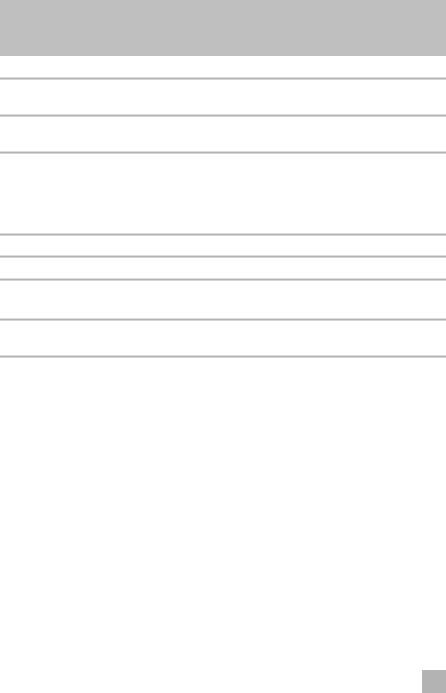
Technische Beschreibung |
PerfectCharge/PerfectPower |
5.1Bedienelemente
Pos. in
Abb. 1, Bedeutung
Seite 3
1Ausgangsklemmen
2LED „Power On“: An den Ausgangsklemmen des Wandlers liegt Spannung an. Der Wandler ist betriebsbereit.
3LED „Battery Low“: Die Eingangsbatterie ist nicht mehr ausreichend geladen.
4LED „Overload“:
–Bei Anschluss eines Verbrauchers: Der Wandler ist kurzgeschlossen oder überlastet.
–Bei Anschluss als Lader: Der Wandler befindet sich in der VollstromLadephase.
5Luftaustritt
6Hauptschalter
7Rot: Plus-Kabel zur Eingangsbatterie Schwarz: Minus-Kabel zur Eingangsbatterie
8Anschlussleitung zum Einschalten mit Bordnetzspannung (z. B. Zündung oder externer Schalter)
28 |
DE |
|

PerfectCharge/PerfectPower |
Wandler montieren |
6Wandler montieren
6.1Montagehinweise
Wenn Sie den Wandler fest montieren möchten, beachten Sie folgende Montagehinweise:
•Sie können das Gerät horizontal oder vertikal montieren.
•Montieren Sie das Gerät nicht
–in feuchter oder nasser Umgebung,
–in der Nähe brennbarer Materialien,
–in explosionsgefährdeten Bereichen.
•Der Einbauort muss gut belüftet sein. Bei Installationen in geschlossenen kleinen
Räumen sollte eine Beund Entlüftung vorhanden sein. Der freie Mindestabstand um das Gerät muss mindestens 5 cm betragen (Abb. 2, Seite 3).
•Der Lufteintritt auf der Unterseite bzw. der Luftaustritt auf der Rückseite des Geräts muss freibleiben.
•Bei Umgebungstemperaturen von mehr als 40 °C (z. B. in Motoroder Heizungsräumen, direkte Sonneneinstrahlung) kann es durch die Eigenerwärmung des Wandlers bei Belastung zum automatischen Abschalten kommen.
•Die Montagefläche muss eben sein und eine ausreichende Festigkeit aufweisen.
AACHTUNG!
Bevor Sie irgendwelche Bohrungen vornehmen, stellen Sie sicher, dass keine elektrischen Kabel oder andere Teile des Fahrzeugs durch Bohren, Sägen und Feilen beschädigt werden.
6.2Wandler montieren
Halten Sie den Wandler an den von Ihnen gewählten Einbauort und markieren Sie die Befestigungspunkte (Abb. 3 A, Seite 3).
Befestigen Sie den Wandler mit der von Ihnen gewählten Befestigungsmethode (Abb. 3 B, Seite 3).
DE |
29 |
|
|
|
|

Wandler anschließen |
PerfectCharge/PerfectPower |
7Wandler anschließen
7.1Wandler an Eingangsbatterie anschließen
!WARNUNG!
Achten Sie darauf, dass die Polarität nicht vertauscht wird. Bei Verpolung der Batterieanschlüsse kann es zu Personenschaden kommen, und das Gerät wird zerstört.
AACHTUNG!
Ziehen Sie die Schrauben oder Muttern mit einem Drehmoment von 12 – 13 Nm fest. Lose Verbindungen können zu Überhitzungen führen.
Stellen Sie den Hauptschalter (Abb. 1 6, Seite 3) auf „0“.
Verlegen Sie das Plus-Kabel (rot) (Abb. 1 7, Seite 3) vom Wandler zum Pluspol der Batterie und schließen Sie es dort an.
Verlegen Sie das Minus-Kabel (schwarz) (Abb. 1 7, Seite 3) vom Wandler zum Minuspol der Batterie und schließen Sie es dort an.
7.2Anschlussleitung anschließen
Sie können das Gerät wie folgt einschalten:
•durch den Hauptschalter am Gerät (Abb. 1 6, Seite 3)
•durch die Zündung (Abb. 5 A, Seite 4) Klemme 15: Geschaltetes Plus
•über einen externen Schalter (Abb. 5 B, Seite 4)
Wandler für Einschalten über Hauptschalter anschließen
Isolieren Sie die Anschlussleitung, damit es zu keiner Fehlfunktion kommt.
Wandler für Einschalten über die Zündung anschließen
Schließen Sie die Anschlussleitung an Klemme 15 (geschaltetes Plus) an (Abb. 5 A, Seite 4).
Stellen Sie den Hauptschalter (Abb. 1 6, Seite 3) auf der Rückseite des Wandlers dauerhaft auf „0“.
30 |
DE |
|
